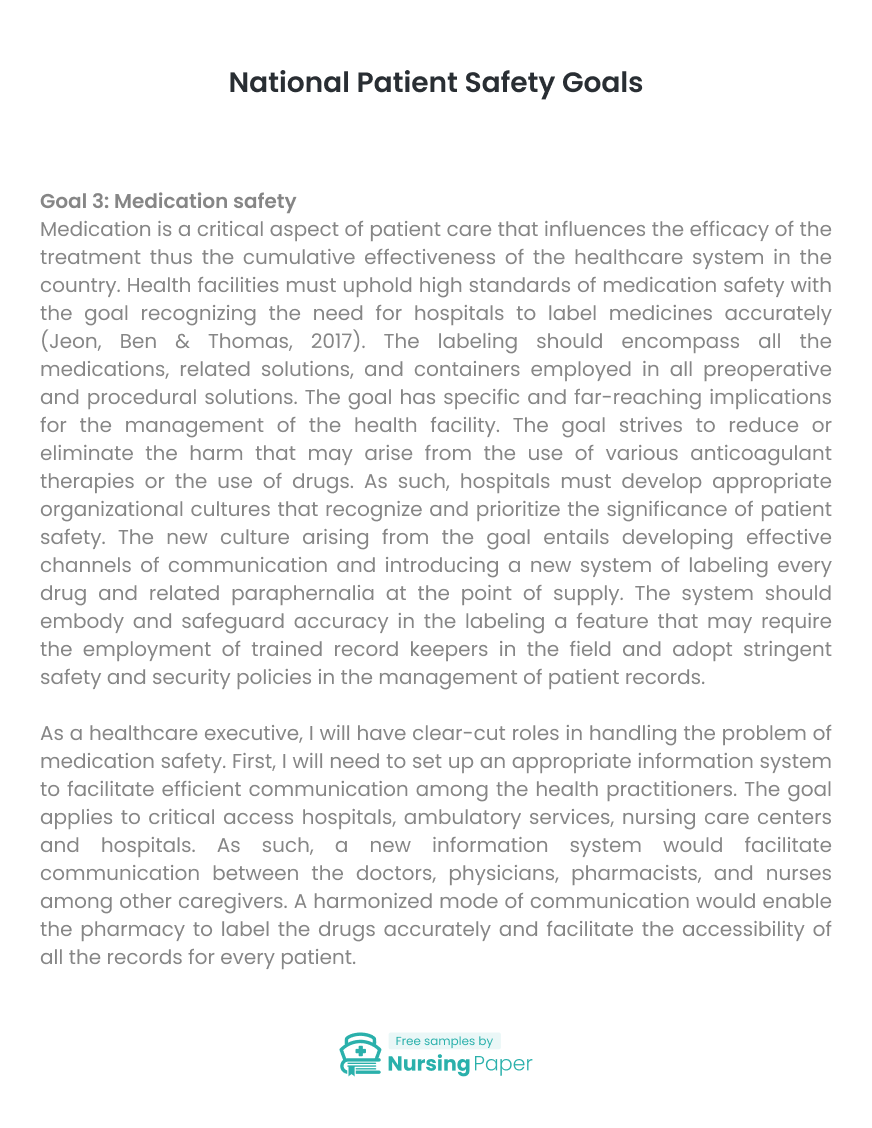
National Patient Safety Goals
Goal 3: Medication safety
Medication is a critical aspect of patient care that influences the efficacy of the treatment thus the cumulative effectiveness of the healthcare system in the country. Health facilities must uphold high standards of medication safety with the goal recognizing the need for hospitals to label medicines accurately (Jeon, Ben & Thomas, 2017). The labeling should encompass all the medications, related solutions, and containers employed in all preoperative and procedural solutions. The goal has specific and far-reaching implications for the management of the health facility. The goal strives to reduce or eliminate the harm that may arise from the use of various anticoagulant therapies or the use of drugs. As such, hospitals must develop appropriate organizational cultures that recognize and prioritize the significance of patient safety. The new culture arising from the goal entails developing effective channels of communication and introducing a new system of labeling every drug and related paraphernalia at the point of supply. The system should embody and safeguard accuracy in the labeling a feature that may require the employment of trained record keepers in the field and adopt stringent safety and security policies in the management of patient records.
As a healthcare executive, I will have clear-cut roles in handling the problem of medication safety. First, I will need to set up an appropriate information system to facilitate efficient communication among the health practitioners. The goal applies to critical access hospitals, ambulatory services, nursing care centers and hospitals. As such, a new information system would facilitate communication between the doctors, physicians, pharmacists, and nurses among other caregivers. A harmonized mode of communication would enable the pharmacy to label the drugs accurately and facilitate the accessibility of all the records for every patient. Besides setting up a new information system, I would strive to develop a new organizational culture. The new culture should recognize the significance of patient safety (Uselton, 2004). The new culture would include introducing new codes of operation that requires the nurses, physicians, doctors, and pharmacists to provide unique identification to every patient upon admittance. The rule would require the stakeholders to ensure appropriate identification of the patient and labeling of all their paraphernalia accordingly. Similarly, my key role would be to ensure the efficiency in the uptake of the new system and culture. I would evaluate the system with the view to improving its efficiency and eliminating errors arising in the attempt to improve medication safety.


Conclusion
Finally, I would recommend specific changes in the management of a health facility to ensure the success in maintaining medication safety. First, I would recommend retraining of the medical staff in the hospital. Training of the critical caregivers is important to enable them to understand the new policies arising from the goal. The need for stringent labeling of medication, syringes, basins, and cups may appear complex and confusing. The management must therefore comprehensive and periodic training of the staff to improve their understanding of the new policies. Similarly, I would recommend that the health facility adopts new and tailored information system that records and passes correct information of a patient’s medicine (Krasker, 2004). The recommendation would require changing the entire information system or introducing new features of identification and tracking patients and their medical histories. Finally, I would recommend a culture of continuous consultation among the caregivers. Nurses in the facility must collaborate with the pharmacists and physicians to safeguard the accuracy of the labeling among other features of medication safety.
1. Jeon, N., Ben, S. & Thomas, J. (2017). Identifying and characterizing preventable adverse drug events for prioritizing pharmacist intervention in hospitals. American Journal of Health System Pharmacy, 74(21): 1774-1783.
2. Krasker, G. (2004). The JCAHO 2005 National Patient Safety Goals: Successful Strategies for Compliance. Washington, DC: HCPro, Incorporated.
3. Uselton, J. (2004). Preparing to Meet Joint Commission Patient Safety Goals: A Supplement to Preparing the Pharmacy for a Joint Commission Survey, 5th Edition. New York: American Society of Health-System Pharmacists.



The download will start shortly.

The download will start shortly.
 Subject:
Medicine
Subject:
Medicine  Number of pages: 2
Number of pages: 2  Subject:
Health and Social Care
Subject:
Health and Social Care  Number of pages: 6
Number of pages: 6  Subject:
Nursing
Subject:
Nursing  Number of pages: 8
Number of pages: 8  Subject:
Nursing
Subject:
Nursing  Number of pages: 3
Number of pages: 3  Subject:
Health and Social Care
Subject:
Health and Social Care  Number of pages: 2
Number of pages: 2  Subject:
Medicine
Subject:
Medicine  Number of pages: 6
Number of pages: 6  Subject:
Nursing
Subject:
Nursing  Number of pages: 2
Number of pages: 2  Subject:
Nursing
Subject:
Nursing  Number of pages: 4
Number of pages: 4  Subject:
Medicine
Subject:
Medicine  Number of pages: 3
Number of pages: 3  Subject:
Medicine
Subject:
Medicine  Number of pages: 5
Number of pages: 5  Subject:
Nursing
Subject:
Nursing  Number of pages: 2
Number of pages: 2  Subject:
Nursing
Subject:
Nursing  Number of pages: 3
Number of pages: 3  Subject:
Nursing
Subject:
Nursing  Number of pages: 5
Number of pages: 5  Subject:
Health and Social Care
Subject:
Health and Social Care  Number of pages: 4
Number of pages: 4 
